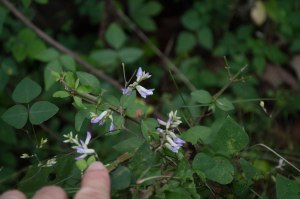Some fabaceous plants in the Maryland piedmont bloom in the spring, but most of the family wait until high summer to get going. The bloom times stated below are approximate – especially early in the season, when they can vary by one or two weeks.

By my observations, the earliest blooming fab in the Maryland piedmont is the redbud (Cercis canadensis), a lovely understory tree that usually starts flowering in May, about the time the dogwoods are finished. It’s a nice addition to a native landscape garden except for one thing: it fruits profusely. The pods are easily raked up with autumn leaves, but invariably some will escape your attention and the following spring you’ll be pulling redbud seedlings out of your garden. (Ask me how I know.) Also, it can grow lanky and the wood is somewhat weak. The tree (and therefore your garden) benefits from thoughtful pruning.

Black locust (Robinia pseudoacacia) can be a spectacular tree in May when flowering, if it gets enough sunlight. But more often you’ll see it in mixed deciduous woodlands, growing very straight and tall with the blossoms hidden in the canopy. The wood is incredibly rot-resistant, making for long-lasting fencing, and has very high BTU value. However, the trees blow over easily and will even shear off horizontally in the right conditions. Again, ask me how I know… At my previous house any time a black locust would break off, I’d cut up the wood for the fireplace but leave the stump for the birds. An eleven-foot stump in my front yard served as a feeder for pileated woodpeckers. Sometimes I miss that place.

a great specimen of black locust growing at wood’s edge —>

Another May bloomer, wild blue indigo (Baptisia australis) is on the RTE* watchlist (S3) in Maryland. I know of two distinct stands of it along the Potomac, where it grows with Culver’s root (Veronicastrum virginicum). I grew wild blue indigo at my previous house, and it is a profuse bloomer. It’s a stunner in the garden but the seedpods are so numerous and heavy, they pull the plant right over. And they germinate in great numbers. If you remove the pods, though, it’s a well-behaved plant.

seedpods on Baptisia australis

Hylodesmum glutinosum (formerly Desmodium glutinosum; pointed-leaf tick-trefoil) blooms in early July. This picture was taken in western New York state. I’ve only seen it here in the Piedmont in one place along the Cabin John Trail, where every year I miss seeing it bloom. It seems to like deep woods and moist soils, and often grows in association with lopseed (Phryma leptostachya). The tick-trefoils can be tricky to identify, but this one is easy because of the large, pointy leaflets (three per leaf):

Also blooming in July, more or less, is the closely related Hylodesmum nudiflorum (formerly Desmodium nudiflorum; naked-flower tick-trefoil). This one is easy to distinguish from other tick-trefoils because there are no leaves on the flowering stem. It grows in more or less the same conditions as the pointed-leaf tick-trefoil, except maybe it wants a bit more sun.

Clitoria mariana (butterfly pea or Atlantic pigeonwings) blooms from late June into August. I’ve seen it in a few places in the Potomac gorge, never in large numbers (usually just one plant growing alone), mostly in open, rocky places. The plants are vining, and stay fairly close to the ground. Butterfly pea is endangered in New Jersey and Pennsylvania.

Panicled tick-trefoil (Desmodium paniculatum) blooms in late August. It grows in moist to dry soils in sun to part shade, and does well in disturbed areas.

Lespedeza virginica (slender bush-clover) is sadly not nearly as common as its alien cousin, Lespedeza cuneata (Chinese bush-clover). You’ll often see the two growing together in dry soils in sunny areas, blooming in August. Slender bush-clover is threatened in New Hampshire and Wisconsin.

Senna hebecarpa (wild senna or wild cassia) is another August blooming plant. It grows up to six feet tall, with rigid stems that seem almost to lignify, and often in such masses that it could be mistaken for a shrub. It’s endangered in Massachusetts and New Hampshire, special concern in Connecticut, threatened in Vermont, and historical in Rhode Island. Wild senna has a nearly identical cousin, S. marilandica, that is rare (S3) in Maryland; Maryland Biodiversity Project has no records for it.

Amphicarpaea bracteata (hog-peanut) is a shortish vine that stays low, twining through other plants, blooming in late August.

And pink fuzzybean (or pink wild bean, or perennial woolly bean; Strophostyles umbellata) is another August blooming vine. It’s endangered in New York and threatened in Rhode Island.
*Rare, Threatened, Endangered
 I hope to post more pictures in a few days, when the iris series is done, but if I wait ’til then these plants will be done blooming, so go looking for them now. Baptisia australis (Fabaceae) is not often see in Maryland. It likes the bedrock terraces in the Potomac Gorge. Be careful of high, fast-moving water and poison ivy. There isn’t much else blooming now, so the color really stands out.
I hope to post more pictures in a few days, when the iris series is done, but if I wait ’til then these plants will be done blooming, so go looking for them now. Baptisia australis (Fabaceae) is not often see in Maryland. It likes the bedrock terraces in the Potomac Gorge. Be careful of high, fast-moving water and poison ivy. There isn’t much else blooming now, so the color really stands out.































